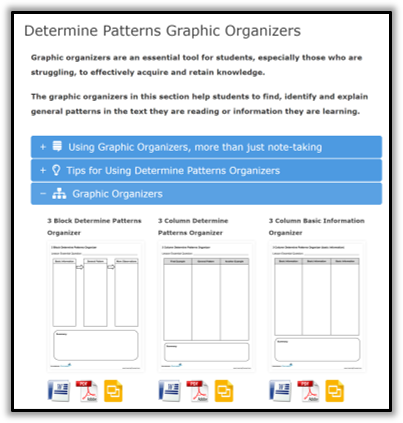High Yield Instructional Strategies Courses
Targeted self-paced professional development that increases your impact.


Not All Strategies are Equal!
The High Yield Instructional Strategies Courses provide teachers with strategies and ideas for planning and using exemplary practices through concise, powerful professional development. These courses give educators a more in-depth understanding of specific Yield Instructional Strategies. Each course supports the effective implementation of a specific strategy by providing additional, high quality examples and ideas to help you move quickly from learning about to using a strategy for its most significant possible impact.
Take me to the courses.
Using the High Yield Strategies provided by Learning-Focused has transformed my planning and made me a better teacher! Invaluable resources!
Whitney Evely, 5th Grade Science and History Teacher
Courses Designed for Implementation
You Will Learn:
- Why it is important to implement.
- What effective implementation looks like.
- The steps in the process for using them most effectively.
- The knowledge and skills necessary to ensure effective implementation.
- How to advance your skills from knowing and randomly trying, to doing with quality.


The Process
- During each course you will have access to virtual presentations covering essential content and performance standards focused on evidenced-based instructional best practices.
- Using our planning process, design template, and a variety of other resources, we provide step by step support for building an action plan that you can immediately implement in your classroom.
- During the training you will learn about a strategy’s different uses and see examples of the strategy in action, helping you put your new training into practice.

- Contact us any time after you have implemented your action plan into your classroom to receive follow up support to make sure you are effectively implementing your training.
- Finally, after completing the presentations, course activities, and collaborative discussions, you will receive your completion certificate, documenting your earned credit hours.
After implementing the high yield text structure instructional practices last school year I was thrilled with the growth of my students.
Elementary School Teacher

Learn with Your Own Team!
Online, Self-Directed Learning
Individuals or teams (i.e. PLC’s or Lesson Study Groups) can learn and improve the implementation of High Yield Instructional Strategies and practices following their own pace.


Onsite, Facilitated Learning
Every High Yield Instructional Strategies Course may also be provided as an onsite professional development workshop at your school with a Learning-Focused instructional specialist. Each course may be presented as a half-day or full-day workshop, depending on your professional learning needs.
Explore the Courses
Review our individual High Yield Strategies Courses to learn more about the focus for each topic, what you will learn and what you will be able to apply. Increase your impact by selecting more than one through one of our bundles or create your own. The bundles are listed below the individual collections.

Accelerating Learning-Focused Lessons introduces a systematic, proactive model that integrates research-based strategies and exemplary practices to support all students in meeting or exceeding grade-level standards. Learn to use effective and efficient teaching and learning practices for supporting and challenging students before, during, and after a lesson to ensure that each student reaches his academic potential.
Course Essential Question: How is Acceleration used to address the needs of all students?
You Will Learn:
- Practices used by exemplary schools to support all learners
- Flaws in models based exclusively on remediation
- Strategies for Previewing, Scaffolding, and providing additional challenge
- Characteristics of effective remediation
You Will Be Able To:
- Explain the rationale for using an Acceleration model
- Incorporate Previewing, Scaffolding, Challenge, and Remediation Strategies to support all learners

Activating Strategies provides a rationale and multiple strategies for preparing students to be successful during lesson instruction. Learn how to use Activating Strategies to engage students, focus attention, and establish “hooks” for new learning. Participants acquire strategies to support students in connecting new learning with their previous knowledge as well as techniques for building background knowledge when students have had limited experiences with the content. They provide the background knowledge and vocabulary students need to be successful during lesson instruction.
Course Essential Question: How are Activating Strategies planned and used effectively?
You Will Learn:
- The purpose of Activating Strategies
- Characteristics of effective Activating Strategies
- A process for effectively planning Activating Strategies
- Examples of Activating Strategies
You Will Be Able To:
- Plan the most effective strategies for activating or building background knowledge in lessons
- Incorporate Higher Order Thinking in Activating Strategies

Assessment Prompts or Formative Assessments focuses on understanding a process for checking for understanding at frequent intervals so there is time to meet students’ learning needs before they are expected to apply new information or complete the Assignment for the lesson. You will learn how to design carefully planned questions or tasks meant to gather evidence that the Learning Goal/Target has been met.
Course Essential Question: How do you plan and use Assessment Prompts effectively?
You Will Learn:
- Types of Assessment Prompts
- Importance of writing as a means of formative assessment
- Strategies for frequently assessing students’ understanding of new learning
- The relationship between the Learning Goal, Assessment Prompt, and Learning Activity
You Will Be Able To:
- Plan Assessment Prompts that align to the Level of Learning of the Learning Goal and Learning Activity
- Use real-time data collection to guide instructional decision-making, and as a means of monitoring and tracking student progress

Collaborative Pairs provides teachers with a planning process that increases teacher effectiveness and accelerates learning by ensuring that Collaborative Pairs are used frequently and effectively throughout a lesson. You will learn how to maximize student learning with a variety of Collaborative Pairs strategies intentionally selected to support the Learning Goals of a lesson. Ideas are given for dealing with management issues and supporting productive talk.
Course Essential Question: How are Collaborative Pairs planned for and used effectively during a lesson?
You Will Learn:
- The rationale for using Collaborative Pairs during lessons
- The importance of planning for Collaborative Pairs during lessons
- Management strategies for using Collaborative Pairs effectively
You Will Be Able To:
- Select Collaborative Pairs strategies according to instructional purpose
- Plan lessons incorporating effective use of Collaborative Pairs
- Provide Scaffolding to support students in engaging in productive collaborative discussions
 Differentiated Assignments addresses how to develop high-quality, relevant assignments that maintain standards-driven learning goals yet are customized to meet the readiness, learning preferences, and interests of all learners. Differentiated Assignments meet the needs of diverse learners while maintaining high standards and expectations for all.
Differentiated Assignments addresses how to develop high-quality, relevant assignments that maintain standards-driven learning goals yet are customized to meet the readiness, learning preferences, and interests of all learners. Differentiated Assignments meet the needs of diverse learners while maintaining high standards and expectations for all.
Course Essential Question: How do you differentiate assignments to meet the needs of diverse learners?
You Will Learn:
- The rationale for differentiating assignments
- Strategies for differentiating for readiness, learning preferences, and interest
You Will Be Able To:
- Differentiate assignments according to readiness, learning preferences, and interests

Distributed Summarizing moves students beyond recall by asking them to represent knowledge and skills in their own words at several points during a lesson. Research has shown that, for students, summarizing increases comprehension and long-term retention of information. Learn how Distributed Summarizing helps you determine which students know the information before you continue on with instruction. When students summarize, their confusions, misconceptions, or misunderstandings surface, and these can be addressed accordingly. It actively requires students to categorize details, eliminate insignificant information, generalize information, and use clear concise language to communicate the essence of the information.
Course Essential Question: How is summarizing planned and effectively used throughout lessons?
You Will Learn:
- Distributed Summarizing Strategies
- The relationship between working memory, attention span and Distributed Summarizing
- Importance of Distributed Summarizing as formative assessment
You Will Be Able To:
- Plan consistently and intentionally details when, where, and how Distributed Summarizing will be used throughout the lesson
- Select Distributed Summarizing tasks to align with Learning Goals and Levels of Learning
- Incorporate multiple opportunities during the lesson for students to respond to questions and prompts for Distributed Summarizing and Distributed Practice prior to independent work
- Carefully monitor students’ thinking/conversations/writing and use their responses to inform instruction

Effective Assignments addresses the fact that students can do no better than the assignments they are given! Align assignments and assessments with the expectations set by your standards. By developing rigorous and challenging assignments and assessments, you can confidently provide students with assignments and assessments that are intellectually demanding. While standards documents set high expectations, the best indicator of actual expectations is the cognitive level of the day-to-day assignments students receive.
Course Essential Question: How do you plan effective assignments that challenge students at high levels?
You Will Learn:
- Reasons effective assignments are so important
- Characteristics of effective assignments
- Steps for planning effective assignments
You Will Be Able To:
- Plan effective assignments that incorporate Higher Order Thinking and writing
- Plan effective assignments that require students to apply all the Learning Goals of a lesson

John Hattie (2009) found that feedback ranked 10th out of 138 factors influencing achievement with a very high effect size of 0.73. Master teachers consistently use distributed formative assessment points throughout their lessons as opportunities to provide specific feedback, informing students how they are doing regarding learning goals, what they need to do to improve, and opportunities to make adjustments based on the feedback. Effective Feedback to Fast Forward Learning includes specific guidelines and strategies to ensure that all feedback moves student learning forward.
Essential Question: How do you purposefully plan Lesson Instruction to engage all students in learning?
You Will Learn:
- Co
- Importance of feedback
- Guidelines for effective feedback
- Strategies for providing feedback
- Strategies for supporting students in using feedback
You Will Be Able To:
- Link feedback to clear learning goals
- Use embedded formative assessment points as opportunities to provide feedback
- Provide informative feedback to help students improve performance
- Equip students with strategies to monitor their learning

Effective Lesson Instruction focuses on how to plan effective lesson instruction that will maximize learning for all of your students. Lesson Instruction consists of four research-based learning strategies: Graphic Organizers, Assessment Prompts, Learning Activities, and Activating Strategies. When purposefully planned according to the lesson's standards-driven Learning Goals, these strategies provide the instruction needed for students to acquire, demonstrate and retain the important grade-level skills and concepts expected in the next generation of standards.
Course Essential Question: How do you purposefully plan Lesson Instruction to engage all students in learning?
You Will Learn:
- Connections among top Research-Based Learning Strategies that comprise effective lesson instruction
- Process for planning effective lesson instruction
- Strategies to promote engagement and increase retention of new learning
- Impact of Research-Based Learning Strategies on learning outcomes
You Will Be Able To:
- Plan effective lesson instruction that connects four of the top Research-Based Learning Strategies
- Incorporate formative assessment strategies to facilitate and monitor students’ learning

Effective Questioning provides a means of questioning students for a variety of purposes - to engage students, focus learning, help students connect to their background knowledge, collect evidence of learning, spark conversations, enhance listening skills, increase the depth of learning, and even just to see who is paying attention. Learn to check students’ understanding at key points during the lesson, and then make adjustments as needed and to promote thinking. This is why effective questioning requires purposeful planning of not only when to ask a question, but that the expected student response will provide evidence of the targeted Learning Goal.
Course Essential Question: How is effective questioning used to advance and assess student learning?
You Will Learn:
- Types of effective questions, including open-ended, Higher Order Thinking, and Reading Comprehension
- Types of student response strategies
- Importance of aligning questions with Levels of Learning
- Follow up strategies for supporting quality student answers
You Will Be Able To:
- Plan questions for each part of Lesson Instruction based on either the Levels of Learning or Comprehension Strategy of each Learning Goal
- Plan response strategies for each question to ensure that all students are engaged and responding to the questions
 Extended Reading Passages are reading passages that align to state assessments. Extended Reading Passages prepare students for reading proficiency after they graduate from high school either in post-secondary education or in their jobs. Learn to evaluate a text for its level of reading endurance as well as how to assess it with text-dependent questions.
Extended Reading Passages are reading passages that align to state assessments. Extended Reading Passages prepare students for reading proficiency after they graduate from high school either in post-secondary education or in their jobs. Learn to evaluate a text for its level of reading endurance as well as how to assess it with text-dependent questions.
Course Essential Question: How do you align classroom assessments to high-stakes tests to prepare students for success?
You Will Learn:
- Reading Pacing Guidelines
- The formula to determine the length of the grade level text
- Schedule guidelines for ongoing practice throughout the year
You Will Be Able To:
- Explain the rationale for using an Extended Reading Pacing schedule
- Plan the types of questions asked during lessons and on classroom assessments to align with questions from high stakes assessments so they replicate the level of rigor, the type of thinking, and the format of major assessments students are held accountable for

Formative Assessments, Feedback and Remediation provide formative assessments to check for understanding and provide specific feedback so students know how they are doing in regard to learning the goals, plus what they need to do in order to improve. Effective teachers use the results of formative assessments to adjust instruction to ensure student success. Adjusting instruction includes immediate modifications during the lesson, as well as providing additional instruction as needed to remediate learning deficits as they are identified, not just at the end of the lesson.
Course Essential Question: How do you use formative assessment, feedback and remediation to ensure successful learning?
You Will Learn:
- Formative assessment, quality feedback, and effective remediation are all dependent on clear Learning Goals
- Strategies for assessments for learning, feedback, and effective remediation
You Will Be Able To:
- Plan and use questions and tasks to formatively assess Learning Goals throughout the lesson with Distributed Summarizing and Practice during Learning Activities, Assessment Prompts, Summarizing Strategies,
and Assignments - Provide quality feedback to students relative to the Learning Goals after each formative assessment
- Use assessment results to adjust instruction and provide remediation to students to help them meet the Learning Goals
- Create a classroom culture that involves students in self-assessment, monitoring their own learning, using feedback, and making adjustments as needed

Graphic Organizers provides teachers with a framework that increases teacher effectiveness and accelerates learning by ensuring that Graphic Organizers are used frequently and effectively throughout a lesson. Teachers will learn how to maximize student learning with a variety of Graphic Organizers intentionally selected and used to support the learning goals of a lesson. Graphic Organizers are an important learning tool that should be used in every lesson to guide thinking, organize information, and support learning.
Course Essential Question: How are Graphic Organizers effectively used during lessons?
You Will Learn:
- The rationale for using Graphic Organizers during lessons
- Steps for effective use of Graphic Organizers
You Will Be Able To:
- Select Graphic Organizers according to instructional purpose
- Adapt to create Graphic Organizers aligned to specific types of thinking required in a lesson
- Explicitly teach the structure and use of Graphic Organizers
- Plan lessons incorporating effective use of Graphic Organizers

Learn to integrate Higher Order Thinking strategies into every lesson to increase rigor, deepen student learning, and challenge students to critically analyze and interpret information to develop new insights. Provide the explicit instruction necessary for students to be able to use Higher Order Thinking strategies skillfully. Rigorous lessons engage students in skillfully applying Higher Order Thinking to deepen their understanding of academic content.
Course Essential Question: How do you increase the rigor of instruction and assignments with Higher Order Thinking?
You Will Learn:
- Steps for effective use of Higher Order Thinking Strategies
- The importance of Higher Order Thinking Strategies for increasing student learning
You Will Be Able To:
- Select Higher Order Thinking Strategies according to the Level of Learning of the Learning Goal
- Explicitly teach the structure and use of Higher Order Thinking Strategies
- Incorporate Higher Order Thinking Strategies throughout lesson instruction

Learning Activities are the means by which students will learn the knowledge and skills specified in the lesson’s Learning Goals. A Learning Activity might have students read a selection, listen to a lecture, complete a web quest, conduct an experiment, engage in a dialogue, or any number of other possibilities. While there are many types of Learning Activities, they cannot be selected randomly. Learn to design Learning Activities so students will be able to successfully accomplish the Learning Goal for that part of the lesson.
Course Essential Question: How do you plan intentional Learning Activities that engage students in learning?
You Will Learn:
- Strategies for student engagement and retention of new learning
- The connection between motivation and explicit instruction
- Steps for planning effective Learning Activities
You Will Be Able To:
- Explain the relationship between the Learning Goal and the Learning Activity
- Incorporate engagement strategies to increase students’ motivation and improve long-term retention of learning

Learning-Focused Lessons is the fundamental workshop that provides schools with a common planning framework that increases teacher effectiveness and accelerates learning by focusing instruction on how students learn and whether students learn. The framework ensures that the top Research-Based Learning Strategies and exemplary practices are purposefully connected in every lesson.
Course Essential Question: How do I use the Learning-Focused Lesson to plan for learning?
You Will Learn:
- Components of Learning-Focused Lessons and the purpose of each
- Steps in planning a Learning-Focused Lesson
You Will Be Able To:
- Plan and implement effective Learning-Focused lessons that connect Research-Based Learning Strategies and exemplary practices

Previewing Strategies introduces a proactive model that integrates Research-Based Learning Strategies and exemplary practices with learning research to support struggling students and accelerate their learning. Learn how Exemplary Schools use Previewing Strategies to support struggling students before the classroom lesson, preparing them to learn during the lesson or unit. Previewing Strategies include advance organizers, activating prior knowledge, vocabulary instruction, graphic organizers, and thinking and writing strategies. When used in combination with remediation and re-teaching, it catches students up that are 1, 2, 3 or more grade levels behind and need more than a year’s worth of growth each school year.
Course Essential Question: How is Previewing used to catch struggling students up?
You Will Learn:
- Rationale for Previewing
- Characteristics of Previewing
- Previewing Strategies
You Will Be Able To:
- Identify Struggle Points in lessons
- Develop Previewing Plans
- Implement Previewing to support struggling students

Raising Rigor provides tools and techniques for planning Learning Goals, Assignments, and Lesson Instruction that will engage and challenge all students, enabling them to meet and exceed the demands of today’s standards. Learn how to plan and provide curriculum, instruction, and assessment that challenges all students while providing the support necessary for all students to be successful.
Course Essential Question: How do you ensure that your lessons are planned to challenge all students?
You Will Learn:
- The relationship between rigor and expectations
- Characteristics of rigorous lessons and assignments
- Criteria for measuring rigor
- Steps and strategies for increasing the rigor of lessons
You Will Be Able To:
- Plan lessons aligned to the level of rigor of the standards
- Plan challenging and engaging assignments
- Plan rigorous Lesson Instruction
- Support students in being self-directed learners

Scaffolding is a high-yield instructional strategy that teachers can use to reduce the negative emotions and self-perceptions that students may experience when grappling to learn skills and concepts. It requires lessons to be broken up into learning chunks, and that teachers provide a tool, or structure, with each chunk. Scaffolding Strategies help teachers maintain the same grade-level standards and learning expectations for all students, even though not every student will have the necessary knowledge or capability to initially perform as intended.
Course Essential Question: How do you plan and use Scaffolding Strategies to accelerate learning?
You Will Learn:
- Types of Scaffolding Strategies
- The Zone of Proximal Development
- The relationships among Learning Goals, Scaffolding, and Struggle Points
- The Criteria for Planning and Implementing Scaffolding
You Will Be Able To:
- Plan consistently and intentionally details of where, when, and how Scaffolding will be used throughout lesson instruction.
- Select Scaffolding Strategies to based on anticipated Struggle Points in a Learning Goal or Learning Activity.
- Use formative assessment data to determine what scaffolds are needed to provide "just in time" learning support.
- Apply the Criteria for Planning and Implementing Scaffolding to old or future lessons.

The function of every classroom is to maximize learning for each student. The physical classroom provides the foundation for effective teaching and learning. When classrooms are filled with an overload of displays and materials, it can overwhelm students and also distract them from their learning. Organized classroom environments decrease distractions for students and focus their attention on their current learning.
Course Essential Question: How do you establish a physical classroom environment to support learning?
You Will Learn:
- Organization principles for visual displays
- Characteristics of a well designed classroom learning environment
- Strategies for maximizing the use of prime classroom space
- Strategies for building students’ independence with visual learning supports
You Will Be Able To:
- Design learning spaces according to the purpose of the space or display
- Incorporate visual learning supports to assist struggling students and build students’ independence in applying new strategies and processes

Today’s curriculum standards emphasize that reading comprehension instruction should be a shared responsibility among all content area teachers. While English/Language Arts teachers have the primary responsibility of developing students’ comprehension skills, teachers in other areas must also support their students’ development as readers. This is achieved by focusing on the connection between the text structure of expository texts and the Reading Comprehension strategies used to understand the content. Explicit instruction and application of the top Reading Comprehension strategies in all content area subjects will support students with understanding complex text and will provide a pathway to accomplish the content and literacy goals defined in the new generation of state standards.
Course Essential Question: How is a focus on reading comprehension and text structures used to deepen understanding in all content areas?
You Will Learn:
- Steps for effective use of Reading Comprehension Strategies and Text Structures
- The importance of Reading Comprehension Strategies and Text Structures for improving student comprehension
You Will Be Able To:
- Select Reading Comprehension Strategies and Text Structures according to expectations in standards, Learning Goals, and curriculum resources
- Explicitly teach the structure and use of Reading Comprehension Strategies and Text Structures
- Incorporate Reading Comprehension Strategies and Text Structures into lesson instruction

Learn to identify which words are critical to learning specific content; select and implement a variety of high impact vocabulary strategies that increase reading and listening comprehension; implement the characteristics of effective vocabulary instruction that increases essential word knowledge as it bridges short-term and long-term memory; create a plan for implementing consistent and pervasive vocabulary instruction that increases learning for all students, and design interactive instructional Word Walls as learning tools.
Course Essential Question: How are Vocabulary Strategies planned and used effectively?
You Will Learn:
- Research related to vocabulary instruction
- 7 Characteristics of Effective Vocabulary Instruction
- Process for selecting critical words for instruction
- The steps in the most effective process for learning new vocabulary
- Activating and Previewing Strategies, In Context Strategies, Summarizing Strategies
- Purpose and Types of Word Walls
- Guidelines for Making, Using and Adapting Word Walls
You Will Be Able To:
- Explain the implications of research for vocabulary instruction
- Apply the Characteristics of Effective Vocabulary Instruction
- Apply the process for selecting critical words for instruction
- Model the most effective process for learning new vocabulary
- Utilize a variety of vocabulary strategies effectively
- Plan and implement systematic vocabulary instruction consistently and pervasively

Writing throughout lessons actively engages students with the content they are learning. There are numerous points throughout the lesson where students can write to deepen their understanding of the content and increase their writing proficiency. In the Assignment, students practice Write to Inform, or formal writing for a specific purpose, while ongoing Write to Learn strategies happen during Lesson Instruction. Students Write to Learn in the form of taking notes, brainstorming, asking critical questions, or as Distributed Summarizing prompts like Quick Writes and Summary Point Writing.
Course Essential Question: How do I effectively embed Writing to Learn and Writing to Inform in content area lessons?
You Will Learn:
- Characteristics of Writing to Raise Achievement
- Differences between Writing to Inform and Writing to Learn
- Writing to Learn Strategies as Distributed Summarizing opportunities throughout Lesson Instruction
- Writing to Inform as the writing purpose for the lesson assignment and assessment
You Will Be Able To:
- Plan lessons with Writing to Inform and Writing to Learn Strategies
- Incorporate writing strategies to support all learners
Course Access = Resources
Getting Started:
Each course is $50 and includes access to planning and support resources through Learning-Focused Online. This is our online portal where you access your courses, as well as all of our implementation resources, including our graphic organizers, anchor charts, picture galleries, videos, and example lessons. Your Learning-Focused Online membership never expires as long as your email address is active!


Explore Our Bundles
Bundle key strategies together to dive more deeply into important areas of teaching and learning! Below is our recommendation for several powerful strategy bundles. If you do not see one that works well with your current improvement goals and education needs, then please revisit the individual course directory and create your own bundle. You always have the power to choose when you use High Yield Instructional Strategies professional development.

Acceleration practices help maintain high expectations for all students by building support for struggling students and addressing the main causes of learning difficulties—a lack of background knowledge and vocabulary. Explore how these practices work together to build students’ self-efficacy and self-esteem, leading to more engaged and confident learners!
- Differentiated Assignments
- Previewing Strategies
- Scaffolding Strategies
- Vocabulary Strategies

Effective Assignments are one of the most important ways to raise student achievement. Understanding the purpose of an assignment provides a solid foundation for planning decisions and developing effective assignments.
These four titles will help you better understand how to maximize the effectiveness of every lesson assignment.
- Effective Assignments
- Differentiated Assignments
- Effective Feedback
- Writing to Raise Achievement
 Explicit instruction and application of the top reading comprehension strategies in all content area subjects will support students' understanding of complex text and provide a pathway to accomplishing the content and literacy goals defined in the Common Core State Standards and the new generation of state standards. Learn more about the reciprocal relationship between reading and writing and how to focus your lessons through this literacy lens.
Explicit instruction and application of the top reading comprehension strategies in all content area subjects will support students' understanding of complex text and provide a pathway to accomplishing the content and literacy goals defined in the Common Core State Standards and the new generation of state standards. Learn more about the reciprocal relationship between reading and writing and how to focus your lessons through this literacy lens.
- Using Reading Comprehension and Text Structures in All Content Areas
- Writing to Raise Achievement
- Vocabulary Strategies
- Effective Questioning
 Specific learning strategies and practices need to be connected during Lesson Instruction. Each strategy has a specific purpose for engaging students and maximizing learning, and combined, they provide a solid foundation for effective lesson instruction!
Specific learning strategies and practices need to be connected during Lesson Instruction. Each strategy has a specific purpose for engaging students and maximizing learning, and combined, they provide a solid foundation for effective lesson instruction!
These four titles will help you better understand how to maximize the effectiveness of every lesson.
- Activating Strategies
- Effective Questioning
- Distributed Summarizing
- Collaborative Pairs
 Standards alone do not guarantee students can become critical thinkers. The key to creating critical thinkers is to plan and provide lessons that connect comprehension and thinking strategies with authentic engagement. Develop the knowledge and skills necessary to ensure every lesson expects students to learn at high levels, supports learning at high levels, and elicits learning at high levels!
Standards alone do not guarantee students can become critical thinkers. The key to creating critical thinkers is to plan and provide lessons that connect comprehension and thinking strategies with authentic engagement. Develop the knowledge and skills necessary to ensure every lesson expects students to learn at high levels, supports learning at high levels, and elicits learning at high levels!
- Higher Order Thinking Strategies
- Using Reading Comprehension and Text Structures in All Content Areas
- Writing to Raise Achievement
- Effective Assignments
 Learn to address the negative effects of poverty by using specific strategies that focus on maximizing engagement and boosting learning by addressing students’ learning needs by focusing lessons on the principles of learning and engagement that matter most for students from lower socioeconomic backgrounds.
Learn to address the negative effects of poverty by using specific strategies that focus on maximizing engagement and boosting learning by addressing students’ learning needs by focusing lessons on the principles of learning and engagement that matter most for students from lower socioeconomic backgrounds.
- Collaborative Pairs
- Vocabulary Strategies
- Graphic Organizers
- Effective Questioning
